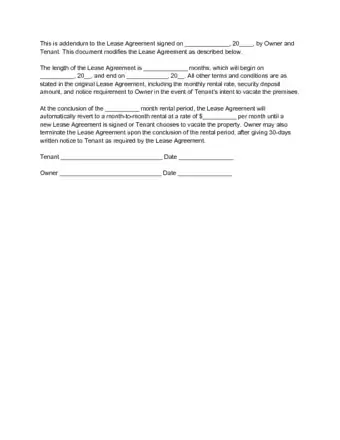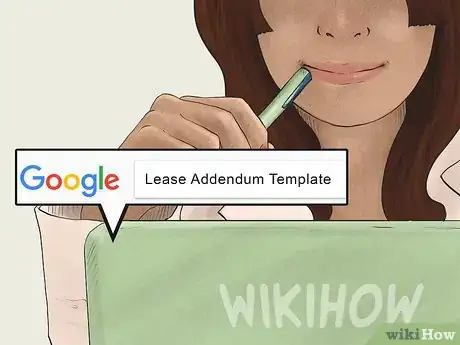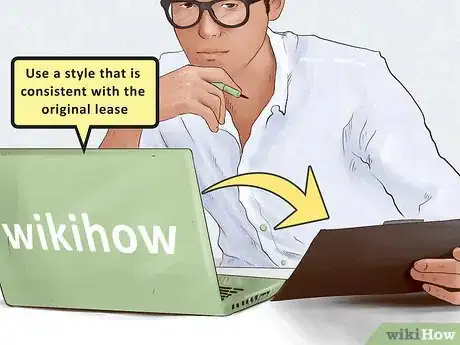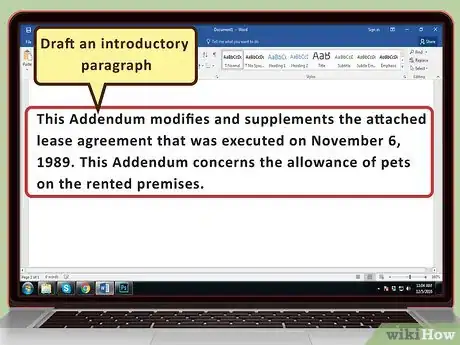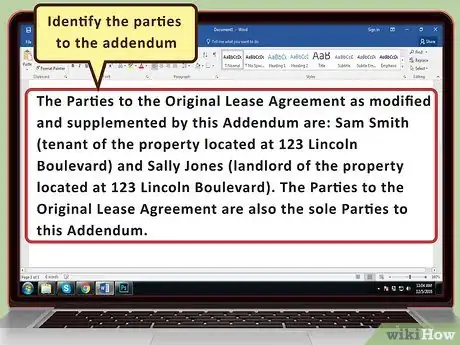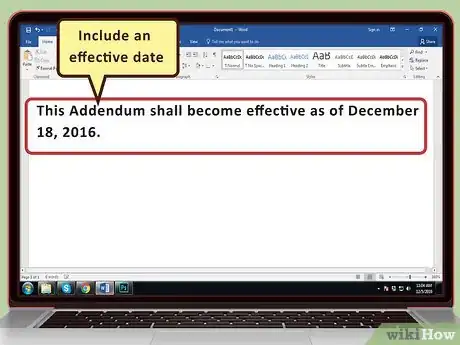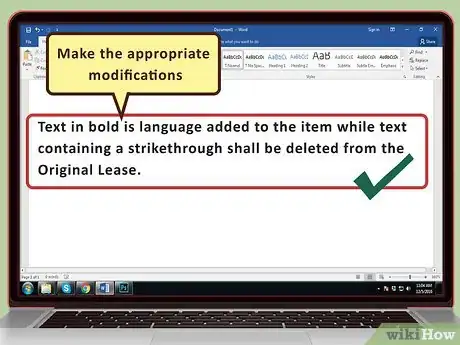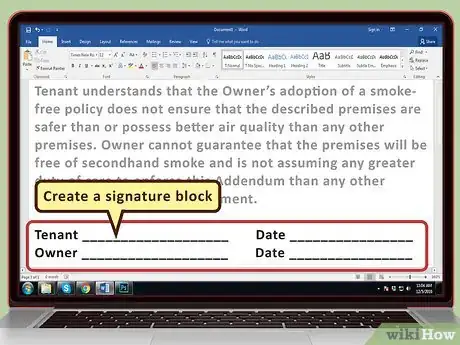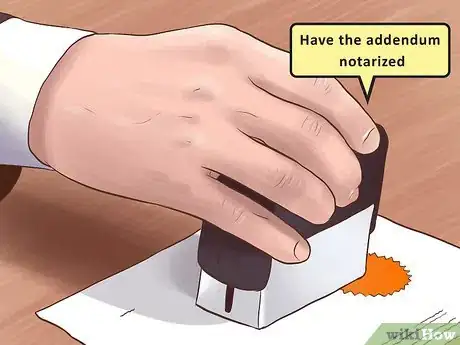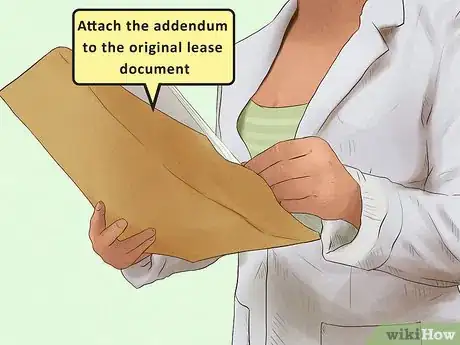This article was co-authored by wikiHow Staff. Our trained team of editors and researchers validate articles for accuracy and comprehensiveness. wikiHow's Content Management Team carefully monitors the work from our editorial staff to ensure that each article is backed by trusted research and meets our high quality standards.
wikiHow marks an article as reader-approved once it receives enough positive feedback. In this case, 90% of readers who voted found the article helpful, earning it our reader-approved status.
This article has been viewed 417,342 times.
Learn more...
Whether you are a landlord or tenant, there may be times when your residential or commercial lease needs to be added to. In these circumstances, you will use a lease addendum to make the required changes. Unlike a lease amendment, which is a change in the contract itself, a lease addendum is an additional document that is added to the existing lease agreement. For example, in the residential lease context, pet ownership, roommate expectations, crime free agreements, and lawn care policies may all be controlled by addenda (if they are not already controlled by the lease itself). In order create an addendum, your original lease needs to not prohibit the action and the addendum needs to meet all basic contract requirements. After you write your addendum, you will need to execute it and include it with your original lease.
Steps
Sample Addendums
Determining Your Ability to Create an Addendum
-
1Understand the purpose of an addendum. An addendum is an addition to an already agreed upon contract. The addendum can be used to add to, subtract from, or compliment the agreement that is already in place. The document will modify the terms of the original agreement and will legally control whatever its subject matter is about.[1]
- Unlike an addendum, an amendment to a lease involves changing the original contract itself. While addenda and amendments are similar, they are not the same.
-
2Contact a qualified lawyer. Whether you are a landlord or tenant, you should always get legal advice before changing the terms of an existing lease. This is the case because an addendum will affect your legal rights. When you are looking for a lawyer, try to find a transactional lawyer comfortable drafting and executing lease agreements and addenda. In a lot of situations, a lawyer will only represent landlords or tenants, not both. Make sure you find the best fit for your needs.
- Start your search by asking friends and family for lawyer recommendations. Lawyers rely on referrals, and it is a great way to find a trustworthy one.
- If you cannot find a lawyer through referrals, contact your state bar association's lawyer referral service. After answering a few general questions, you will be put in contact with multiple qualified lawyers in your area.
Advertisement -
3Check your original lease for an amendment or addendum provision. In a lot of situations, the original lease will have a provision specifying when addenda are allowed, what they can cover, who can execute them, and how they need to be drafted. Review the original contract to make sure the addendum you want to draft is allowed.
- For example, your lease might state that no addenda are allowed. In this case, you will have to perform under the original lease or negotiate a new one.
- In some cases, addenda may only be allowed to cover certain things (e.g., pets) but not others (e.g., extra roommates).[2]
-
4Make sure the addendum will meet all the basic requirements of a contract. An addendum is technically a legal contract on its own, and it therefore must meet all the requirements of a valid contract. Generally speaking, a valid contract is formed when both parties are competent and when you have an offer, acceptance, and consideration.
- Parties are competent when they are over 18 years of age and free from any mental impairment (e.g., being under the influence of drugs or alcohol, having a mental disability).
- The offer, acceptance, and consideration can be summed up to say that both parties need to mutually agree to do something, or refrain from doing something, and that the parties must exchange something of value. For example, if you sign an addendum to allow a pet in one of your units, you are giving the tenant that right in exchange for a pet deposit or increased rent. This is consideration.[3]
Writing the Addendum
-
1Look for templates and examples. Try to avoid creating a lease addendum from scratch. Not only will it be time consuming, it will also lead to improper and dangerous language that could adversely affect your legal rights. Contracts are a form of technical writing and the language is complex and detailed for a reason. Therefore, look for addendum templates and examples. Use the language in those agreements to help guide you.
- While using templates is incredibly helpful, you should not just copy and paste. Work with the examples and edit them to fit your needs.
-
2Use a style that is consistent with the original lease. The addendum should look and sound like the original lease so it is apparent the two documents are connected. You can accomplish this by using the same font, font size, and margins.[4] Additionally, use the same language that is in the original lease as much as possible to keep things consistent.
-
3Title the addendum appropriately. The title of your addendum should reference and identify the original lease. This will again help connect the two documents. For example, you might title your addendum: "Addendum to the Original Lease Contract Executed on November 6, 1989."[5]
-
4Draft an introductory paragraph. The first paragraph of your addendum should lay out the purpose of the document. This will let both parties know that the addendum is modifying an existing contract. For example, your opening paragraph might read: "This Addendum modifies and supplements the attached lease agreement that was executed on November 6, 1989. This Addendum concerns the allowance of pets on the rented premises."[6]
-
5Identify the parties to the addendum. The next provision should clearly identify the parties to the addendum. In addition to including the parties' names, you can also include other identifying information (e.g., their relationships to one another, their titles, and the property involved).[7]
- For example, you could identify the parties by stating: "The Parties to the Original Lease Agreement as modified and supplemented by this Addendum are: Sam Smith (tenant of the property located at 123 Lincoln Boulevard) and Sally Jones (landlord of the property located at 123 Lincoln Boulevard). The Parties to the Original Lease Agreement are also the sole Parties to this Addendum."[8]
-
6Include an effective date. The addendum needs to inform the parties of when the terms will become effective.[9] Without this information, the addendum will be ambiguous and there could be a dispute about when the addendum becomes controlling. For example, if you are a tenant and the landlord is allowing an addendum to let you have a pet, if the addendum doesn't have an effective date, you will not know when you can bring your pet to your rental unit.
- To include this information in your addendum, simply add the following sentence: "This Addendum shall become effective as of December 18, 2016."
-
7Discuss possible conflicts between the original lease and the addendum. Your addendum should inform both parties of what document will control in the event of conflicts. Because your addendum is likely going to modify or contradict the original lease, this particular clause is incredibly important. It should indicate that whenever there is a conflict between the original lease and the addendum, the addendum will control and supersede the original lease.
- For example, an appropriate provision might state: "The parties agree that wherever there is any conflict between this Addendum and the Original Lease, the provisions of this Addendum will control and the Original Lease will be construed accordingly."[10]
-
8Make the appropriate modifications. The body of your addendum will describe the amendments being made with as much detail as possible. Specify whether each item in the addendum is replacing, amending, or supplementing an item in the original lease. Also use this area to incorporate the original lease into the new addendum.[11]
- For example, one paragraph may read: "Paragraph 1 of the Original Lease shall be modified in the following manner. [Modified language will go here]."
- Use strikethroughs and bolded fonts to make your point. However, be sure you define what the purpose of these things are. For example, you might say: "Text in bold is language added to the item while text containing a strikethrough shall be deleted from the Original Lease."
-
9Create a signature block. The end of the addendum should include space for signatures. You should include lines where each party can sign, date, and print their name.[12]
Executing the Addendum
-
1Make sure each party agrees to the terms of the addendum. Once the addendum has been drafted, send it to the other party. Let them review it for accuracy and completeness. Before the addendum is signed, both parties need to understand what they are agreeing to.[13]
- If the other party has any questions or concerns about the addendum, negotiate an acceptable agreement and re-draft the addendum as necessary.
-
2Get the signature of every party. To demonstrate both parties' assent to the addendum and its terms, you and the other party need to sign the agreement in order to execute it. Sign the agreement in the appropriate location in the signature block and date it.
- However, in some leases, the original document might define who needs to sign the agreement. For example, maybe only the landlord needs to sign the addendum or vice versa.[14]
-
3Have the addendum notarized. If required, or agreed to, you can get the signatures notarized, which will help prove that each party did in fact sign the agreement. A notary is a licensed professional who will witness each party sign the agreement. At the end, the notary will put their stamp of approval on the document saying they swear they saw each party sign it.
-
4Attach the addendum to the original lease document. Once the addendum has been executed, it should be attached to the original lease. You can make copies for your records as well.
Community Q&A
-
QuestionHow do I write an addendum to change our names as landlords to an LLC?
 Community AnswerYou don't need an addendum. The LLC is a separate legal entity, therefore you need an assignation (aka assignment) to transfer the landlord's interest in the lease from you to the LLC.
Community AnswerYou don't need an addendum. The LLC is a separate legal entity, therefore you need an assignation (aka assignment) to transfer the landlord's interest in the lease from you to the LLC. -
QuestionCan an addendum be added after the lease has been signed?
 Community AnswerIf both parties agree to the terms and conditions of the addendum and if both initial the addendum indicating acceptance.
Community AnswerIf both parties agree to the terms and conditions of the addendum and if both initial the addendum indicating acceptance. -
QuestionIs there a limit to how many addendums can be added to one lease?
 Community AnswerIf the landlord and tenant agree and have signed the agreements, all addendums are acceptable and binding.
Community AnswerIf the landlord and tenant agree and have signed the agreements, all addendums are acceptable and binding.
References
- ↑ http://thelawdictionary.org/article/writing-a-contract-addendum/
- ↑ http://info.legalzoom.com/incorporating-addendum-contract-23653.html
- ↑ http://smallbusiness.findlaw.com/business-contracts-forms/contracts-basics.html
- ↑ http://thelawdictionary.org/article/writing-a-contract-addendum/
- ↑ http://thelawdictionary.org/article/writing-a-contract-addendum/
- ↑ https://osc.hul.harvard.edu/sample_addendum/
- ↑ http://thelawdictionary.org/article/writing-a-contract-addendum/
- ↑ https://osc.hul.harvard.edu/sample_addendum/
- ↑ http://thelawdictionary.org/article/writing-a-contract-addendum/
- ↑ https://osc.hul.harvard.edu/sample_addendum/
- ↑ http://thelawdictionary.org/article/writing-a-contract-addendum/
- ↑ http://thelawdictionary.org/article/writing-a-contract-addendum/
- ↑ http://info.legalzoom.com/incorporating-addendum-contract-23653.html
- ↑ http://info.legalzoom.com/incorporating-addendum-contract-23653.html
About This Article
An addendum is an addition or subtraction to an existing lease as opposed to a change to the original contract. To write an addendum, first check your original lease to make sure it permits addendums. If it does, go ahead. Look online for a template related to your addendum purpose so you don't need to draft it yourself. When you title your addendum, reference the original lease, like, “Addendum to the original lease contract executed on November 6, 1989.” Specify the purpose of the addendum, like allowing pets or adding a tenant. Remember to name all the parties the addendum affects and include the effective date. Make sure there’s a signature box at the bottom so the tenant and owner can sign it. For more tips, including how to draft an introductory paragraph for your addendum, read on!


